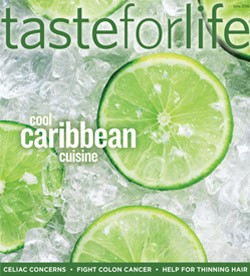For an excerpt from the article, CLICK HERE
Those are not Bananas, simple townsmen all.
(Plantains from Canaryward maybe!)
For the true are red and gold, and they fill no
steamer’s hold,
But flourish in a rare country,
(That men go far to see.)
—Rudyard Kipling, from “A Song of Bananas”
Cashew-Cardamom Banana Coconut Smoothie
Nut butter and banana are a “modern classic” combination. This tropical drink does triple duty as an instant breakfast, power snack, and low-key dessert. With great fats from the coconut milk and flavorful cashews, a sensuous mouthfeel from the sweet, buttery banana flesh, and exciting tropical flavors, this creamy smoothie provides all of the soothing feelings of decadent desserts without any of the repercussions.
Serves 2
For Recipe, CLICK HERE
Poet’s Note
The poet Matsuo Basho got his popular name from the Japanese word for “banana.” In the poet’s garden, a devout student planted a basho that then became a source of inspiration for his poetry and a symbol for his life and his home. The term banana comes from the Wolof language of West Africa, where the fruit (which grows on a “tree” that is technically an unusual herb) was cultivated as far back as 400 CE. The banana itself originated in New Guinea, India, and Southeast Asia, where it was cultivated thousands of years before making its way to Africa. It has long been an important spiritual symbol in Burmese, Thai, and Malay folklore and traditions. The Roman Pliny called the banana “the fruit of the wise,” and in the 4th century, Theophrastus elaborated on the legend that it made people smart. Often referred to in Islamic texts, it was widely disseminated with the spread of Islam, and later by the Portuguese and the Spanish, including Friar Tomas de Berlanga, who brought it to the Americas.
In the modern era, the song “Yes! We Have No Bananas” was for many decades the best-selling sheet music in history, and it always experiences a revival during a banana shortage. In poems such as “The United Fruit Company” in Canto General, Neruda recounts the sad history underlying the big business of banana production and distribution.
The cashew nut (which is actually not a not but a seed) is also quite tropical. Its name derives from the Portuguese word caju, which in turn derives from a native Brazilian Tupi word. Unshelled cashews are equipped with strong defenses—especially an acrid shell oil. Portuguese colonists learned the challenging technique of shelling cashews from Amazonian natives, who roasted them over a fire to neutralize the oils and remove the casings. The Portuguese brought cashews to Southeast Asia, where they’re used extensively to thicken water-based dishes from soups to stews to desserts. The Portuguese also introduced this rich, buttery nut to India, which is now a leading producer of cashews as well as cardamom.
Cardamom—which is indigenous to India and a common ingredient in Indian dishes, sweets, and teas—traveled precisely the opposite way, and is now produced in great abundance in South America. Cardamom gives you good breath and is used to make mints. In the Greek of the New Testament, the word for “cardamom” is amomon, which means “blameless” or “beyond reproach”—fitting for this mystery of the rainforest whose savor and bite are part aromatic mint, part rain-drenched flower, and part citrusy syrup.
Basho on Basho
Crane cries hah-hee-ho!
Its voice rips
in wind: banana leaf tears.
—after Matsuo Basho,
by Stephen Massimilla and Myra Kornfeld

